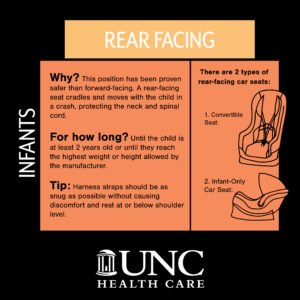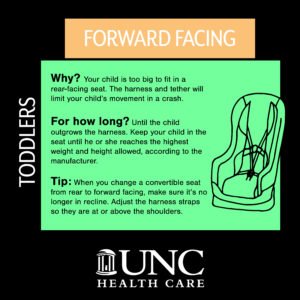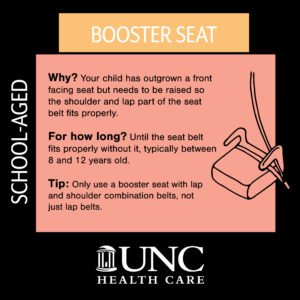When Can a Child No Longer Use a Car Seat
The statistics are enough to give any parent a sick feeling: Each week, about a dozen children ages 12 and under are killed in traffic accidents. Many more are injured, sometimes seriously.
Research shows that many of these children were not buckled in properly, despite the safety and legal consequences (a ticket for driving an unrestrained child in North Carolina results in fines and license points).
60 to 80 percent of car seats are not being used properly, according to child safety expert and registered nurse Robin Deal.
So making sure children are restrained properly is crucial. But finding the right car seat and installing it correctly is no easy task. In fact, 60 to 80 percent of car seats are not being used properly, according to UNC REX Healthcare child safety expert and registered nurse Robin Deal.
"If I had to give one piece of advice to people who are putting their seats in, it would be to read your owner's manual for both your car and your child safety seat. Otherwise, you don't know how to use it," says Deal. "Your car owner's manual tells you where you can put child safety seats. And your child safety seat manual tells you how to install the seat. Many car seat manufacturers have demos on their websites of how to install the seats."
Car seats that are not properly used do not protect children in crashes. That's why it's important to remember these three things:
- The car seat must be the right type for your child's age and size.
- Your child must be properly buckled into the car seat.
- The car seat must be correctly buckled to the car.
So how do you know which car seat is right for your child? And how do you know when to transition your child to another type of seat? Here's what you need to know.
Infants and Toddlers: Rear-Facing Car Seat
Why? In a crash, a rear-facing seat cradles and moves with your child to reduce the stress to his or her fragile neck and spinal cord. The rear-facing position has been proved safer than forward-facing.
For how long? Children should ride in a rear-facing car seat until they're at least 2 years old or until they reach the highest weight or height allowed by the car seat's manufacturer. "Too many people are in a hurry to turn their babies around," Deal says.
Tip: Harness straps should be as snug as possible without causing physical discomfort. They should rest at or below shoulder level.
There are two types of rear-facing car seats:
Infant-Only Car Seat: This small, portable seat is designed for newborns or small babies and can only be used rear-facing. Babies usually outgrow their infant car seats by the time they're 8 or 9 months old. When this happens, change to a convertible or all-in-one car seat, and use it rear-facing until age 2.
Convertible Seat: A convertible seat can change from a rear-facing seat to a forward-facing seat. It can be used with children of various sizes, including newborns.
Toddlers and Preschoolers: Forward-Facing Car Seat
 Why? Eventually, your child will be too big to fit in a rear-facing seat. Forward-facing seats have a harness and tether that limits your child's forward movement during a crash.
Why? Eventually, your child will be too big to fit in a rear-facing seat. Forward-facing seats have a harness and tether that limits your child's forward movement during a crash.
For how long? Children should ride in a front-facing car seat until they outgrow the harness on the car seat. The upper weight limit for harnesses is typically 40 pounds, but several newer models have harnesses that withstand more weight for bigger children. Review your car seat manual to determine the highest weight or height allowed, and keep your child in the seat until he or she reaches that point.
Tip: "When you change a convertible seat from rear-facing to forward-facing, make sure it is no longer in a recline angle," Deal says. "Also, adjust the harness straps so they are at or above the shoulders."
School-Aged Children: Booster Seat

Why? Booster seats raise children up so that the shoulder and lap part of the seat belt fits properly. You should use a booster seat once your child has outgrown a front-facing seat.
For how long? North Carolina law states that when a child reaches age 8 (regardless of weight) or 80 pounds (regardless of age), he or she can transition to a regular seat belt. But the American Academy of Pediatrics urges more caution than the law, saying that seat belts typically fit properly when a child has reached 4 feet 9 inches in height and is between 8 and 12 years old. So even if your child is 8, if the seat belt does not fit properly, wait until it does.
Tip: Use a belt-positioning booster seat only with lap-and-shoulder combination belts and never with just a lap belt. It's safer, and it's the law.
Older Children: Seat Belt, Every Time

Why: Seat belts save lives, for kids and adults.
Tip: Children old enough and large enough to use a seat belt without a booster seat should always use lap-and-shoulder seat belts. Children younger than 13 should not sit in the front seat.
Need help installing your car seat? UNC REX Healthcare offers free inspections. To learn more, call (919) 784-1802.
MORE CAR SEAT TIPS
- Car seats that are more than 10 years old or have passed the manufacturer-specified expiration date should not be used. Any car seat, regardless of age, that has been in a severe crash should be replaced.
- Either the vehicle seat belt or LATCH (Lower Anchors and Tethers for Children) system should be used to install the car seat. LATCH is found on most car seats and vehicles manufactured after Sept. 1, 2002.
Source: buckleupnc.org
When Can a Child No Longer Use a Car Seat
Source: https://healthtalk.unchealthcare.org/the-right-car-seat-for-your-child-at-every-age-and-size/
0 Response to "When Can a Child No Longer Use a Car Seat"
Post a Comment